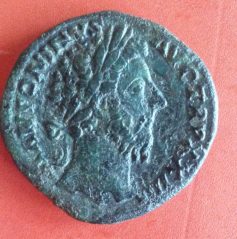“……nota aeris eius fuit ex altera parte Ianus geminus ex altera rostrum navis….” (Plinius Senior, Historia Naturalis, Liber XXXIII)
(M. Valentini) – The As (As, Assis) was the basic unit of the Roman monetary system. It was a bronze or copper currency (a cast coin in the beginning and a struck coin later, after the reduction of its weight).
Originally, an As likely weighed between 327 and 270 grammes, i.e. it was linked to the Roman pound standard, the libra (actually the pound in grammes of a Roman libra is still uncertain, it is believed to be in the range 327-350 grammes, while the so-called Latin libra weighed about 270 grammes). Such a heavy cast bronze coin was called “Aes grave” (Aes, Aeris in Latin means bronze or copper). It was the first circular Roman currency which followed the so-called Aes signatum, a rectangular ingot bearing a mark of the Roman authority weighing between 1.15 and 1.85 kilos (i.e. about 5 librae). At least for a certain period, the Aes grave and the Aes signatum circulated in parallel as legal tender.
The introduction of the Aes grave is also uncertain. Traditionally, it is believed that the Aes grave could be already used around the 450 BC while more recent studies suggest that it could be introduced after the 350 BC.


The weight of the As, therefore the quantity of bronze/copper contained in the coin, diminished over time. Plinius, in his masterpiece “Historia Naturalis” (Book 33), stated that the weigth in copper/bronze of the As was reduced to 2 ounces (“…..constitutumque ut asses sextantario pondere ferirentur“, i.e. was decided to reduced the weight of the Asses to 1/6 of a pound) during the first Punic War (264-241 BC). At the end of the 2nd century, the As’ weight was around 30 grammes. Under the Emperor Augustus (27 BC-14 CE), it weighed about 9-12 grammes.
See below the denominational marks for the As and submultiples thereof.
| Denomination | Division of an As | Denominational mark |
| As | 1 (originally equal to 1 libra) | I |
| Semis | 1/2 as | S |
| Triens | 1/3 as | •••• (4 unciae) |
| Quadrans | 1/4 as | ••• (3 unciae) |
| Sextans | 1/6 as | •• (2 unciae) |
| Uncia | 1/12 as | • (1 uncia) |
Multiples of the As were introduced too, such as the Dupondius (2 asses), Sestertius (21⁄2), Tressis (3), Quadrussis (4), Quinquessis (5) and Decussis or Denarius (10 asses). Actually, the most common coins, multiples of the As, used both under the Roman Republic and the Principatus – with different value and pound over time – were the Dupondius, the Sestertius and the Denarius (the latter after being converted in a lighter silver coin).
Below some heavy bronze Asses (225-217 BC) exposed at the Musei Capitolini in Rome.

_____________
References:
- Coinage of the Roman Republic (CRRO), http://numismatics.org/crro/
- Moneta e Civiltà, Università di Roma Tor Vegata, Facoltà di Lettere e Filosofia, Cattedra di Numismatica, http://www.monetaecivilta.it/
- Plinius “Historia Naturalis”, Libri XXXIII-XXXV, English Translation by H. Rackham, Harvard University Press, 1961.
- Roman Republic Coins Catalogue, British Museum, https://www.britishmuseum.org/research/publications/online_research_catalogues/rrc/preface.aspx


